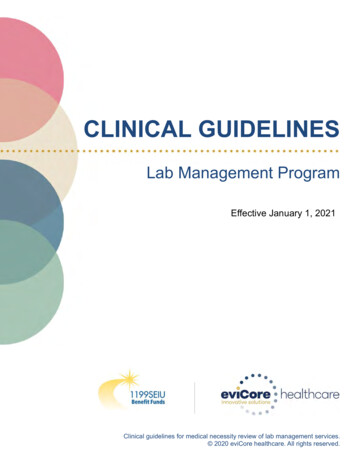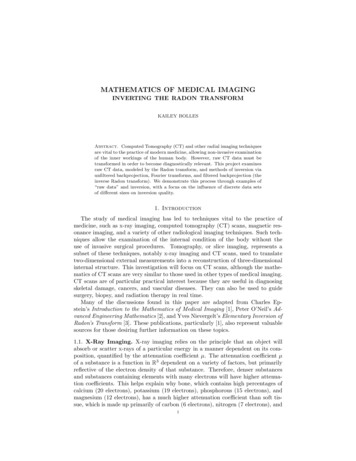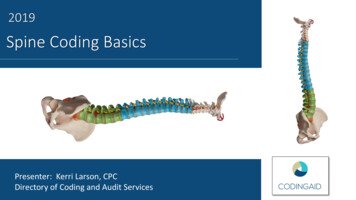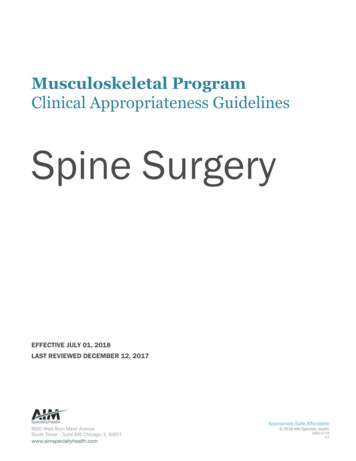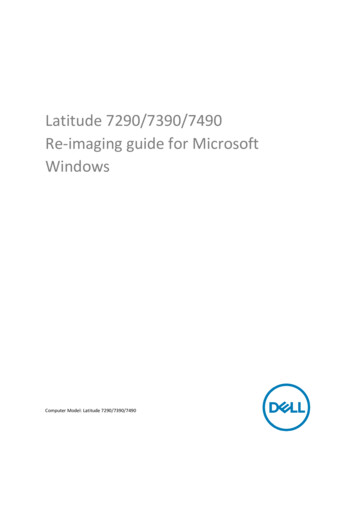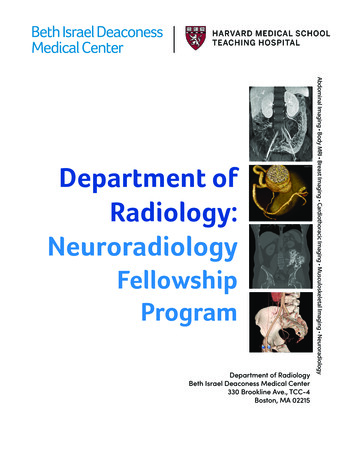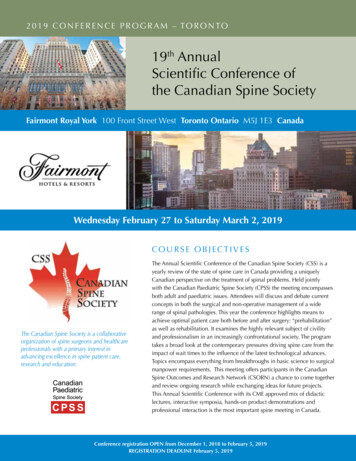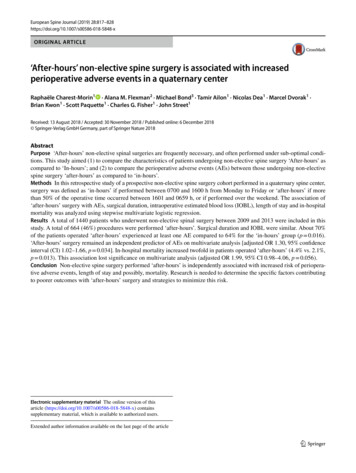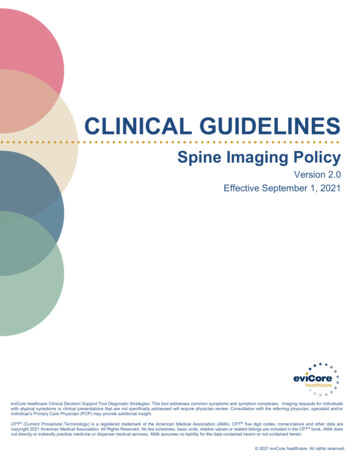
Transcription
CLINICAL GUIDELINESSpine Imaging PolicyVersion 2.0Effective September 1, 2021eviCore healthcare Clinical Decision Support Tool Diagnostic Strategies: This tool addresses common symptoms and symptom complexes. Imaging requests for individualswith atypical symptoms or clinical presentations that are not specifically addressed will require physician review. Consultation with the referring physician, specialist and/orindividual’s Primary Care Physician (PCP) may provide additional insight.CPT (Current Procedural Terminology) is a registered trademark of the American Medical Association (AMA). CPT five digit codes, nomenclature and other data arecopyright 2021 American Medical Association. All Rights Reserved. No fee schedules, basic units, relative values or related listings are included in the CPT book. AMA doesnot directly or indirectly practice medicine or dispense medical services. AMA assumes no liability for the data contained herein or not contained herein. 2021 eviCore healthcare. All rights reserved.
Spine Imaging GuidelinesV2.0Spine Imaging GuidelinesProcedure Codes Associated with Spine Imaging3SP-1: General Guidelines5SP-2: Imaging Techniques14SP-3: Neck (Cervical Spine) Pain Without/With NeurologicalFeatures (Including Stenosis) and Trauma22SP-4: Upper Back (Thoracic Spine) Pain Without/With NeurologicalFeatures (Including Stenosis) and Trauma26SP-5: Low Back (Lumbar Spine) Pain/Coccydynia withoutNeurological Features29SP-6: Lower Extremity Pain with Neurological Features(Radiculopathy, Radiculitis, or Plexopathy and Neuropathy) With orWithout Low Back (Lumbar Spine) Pain33SP-7: Myelopathy37SP-8: Lumbar Spine Spondylolysis/Spondylolisthesis40SP-9: Lumbar Spinal Stenosis43SP-10: Sacro-Iliac (SI) Joint Pain, InflammatorySpondylitis/Sacroiliitis and Fibromyalgia45SP-11: Pathological Spinal Compression Fractures48SP-12: Spinal Pain in Cancer Patients50SP-13: Spinal Canal/Cord Disorders (e.g. Syringomyelia)51SP-14: Spinal Deformities (e.g. Scoliosis/Kyphosis)53SP-15: Post-Operative Spinal Disorders56SP-16: Other Imaging Studies and Procedures Related to the SpineImaging Guidelines59SP-17: Nuclear Medicine632 2021 eviCore healthcare. All Rights Reserved.400 Buckwalter Place Boulevard, Bluffton, SC 29910 (800) 918-8924www.eviCore.com
Spine Imaging GuidelinesV2.0Procedure Codes Associated with SpineImagingMRI/MRACervical MRI without contrastCervical MRI with contrastCervical MRI without and with contrastThoracic MRI without contrastThoracic MRI with contrastThoracic MRI without and with contrastLumbar MRI without contrastLumbar MRI with contrastLumbar MRI without and with contrastSpinal Canal MRAMRI Pelvis without contrastMRI Pelvis with contrastMRI Pelvis without and with contrastMR SpectroscopyMagnetic resonance spectroscopy, determination and localization ofdiscogenic pain (cervical, thoracic, or lumbar); acquisition of single voxel data,per disc, on biomarkers (ie, lactic acid, carbohydrate, alanine, laal, propionicacid, proteoglycan, and collagen) in at least 3 discsMagnetic resonance spectroscopy, determination and localization ofdiscogenic pain (cervical, thoracic, or lumbar); transmission of biomarker datafor software analysisMagnetic resonance spectroscopy, determination and localization ofdiscogenic pain (cervical, thoracic, or lumbar); postprocessing for algorithmicanalysis of biomarker data for determination of relative chemical differencesbetween discsMagnetic resonance spectroscopy, determination and localization ofdiscogenic pain (cervical, thoracic, or lumbar); interpretation and reportCTCervical CT without contrastCervical CT with contrast (Post-Myelography CT)Cervical CT without and with contrastThoracic CT without contrastThoracic CT with contrast (Post-Myelography CT)Thoracic CT without and with contrastLumbar CT without contrast (Post-Discography CT)Lumbar CT with contrast (Post-Myelography CT)Lumbar CT without and with contrastCT Pelvis without contrastCT Pelvis with contrastCT Pelvis without and with contrastCPT 721957219672197763900609T0610T0611T0612TCPT 72193721943 2021 eviCore healthcare. All Rights Reserved.400 Buckwalter Place Boulevard, Bluffton, SC 29910 (800) 918-8924www.eviCore.com
Spine Imaging GuidelinesSpinal canal ultrasoundV2.0UltrasoundNuclear MedicineBone Marrow Imaging, LimitedBone Marrow Imaging, MultipleBone Marrow Imaging, Whole BodyBone or Joint Imaging, LimitedBone or Joint Imaging, MultipleBone Scan, Whole BodyBone Scan, 3 Phase StudyRadiopharmaceutical localization of tumor, inflammatory process ordistribution of radiopharmaceutical agent(s) (includes vascular flow and bloodpool imaging, when performed); planar, single area (e.g., head, neck, chest,pelvis), single day imagingRadiopharmaceutical localization of tumor, inflammatory process ordistribution of radiopharmaceutical agent(s) (includes vascular flow and bloodpool imaging, when performed); planar, 2 or more areas (e.g., abdomen andpelvis, head and chest), 1 or more days imaging or single area imaging over2 or more daysRadiopharmaceutical localization of tumor, inflammatory process ordistribution of radiopharmaceutical agent(s) (includes vascular flow and bloodpool imaging, when performed); planar, whole body, single day imagingRadiopharmaceutical localization of tumor, inflammatory process ordistribution of radiopharmaceutical agent(s) (includes vascular flow and bloodpool imaging, when performed); tomographic (SPECT), single area (e.g.,head, neck, chest, pelvis), single day imagingRadiopharmaceutical localization of tumor, inflammatory process ordistribution of radiopharmaceutical agent(s) (includes vascular flow and bloodpool imaging, when performed); tomographic (SPECT) with concurrentlyacquired computed tomography (CT) transmission scan for anatomicalreview, localization and determination/detection of pathology, single area(e.g., head, neck, chest, pelvis), single day imagingRadiopharmaceutical localization of tumor, inflammatory process ordistribution of radiopharmaceutical agent(s) (includes vascular flow and bloodpool imaging, when performed); tomographic (SPECT), minimum 2 areas(e.g., pelvis and knees, abdomen and pelvis), single day imaging, or singlearea imaging over 2 or more daysCPT 76800CPT 7880378830788314 2021 eviCore healthcare. All Rights Reserved.400 Buckwalter Place Boulevard, Bluffton, SC 29910 (800) 918-8924www.eviCore.com
Spine Imaging GuidelinesSP-1: General GuidelinesSP-1.0: General GuidelinesSP-1.1: General ConsiderationsSP-1.2: Red Flag IndicationsSP-1.3: DefinitionsV2.0689125 2021 eviCore healthcare. All Rights Reserved.400 Buckwalter Place Boulevard, Bluffton, SC 29910 (800) 918-8924www.eviCore.com
Spine Imaging GuidelinesV2.0SP-1.0: General Guidelines Before advanced diagnostic imaging can be considered, there must be an initialface-to-face clinical evaluation as well as a clinical re-evaluation after a trial of failedconservative therapy; the clinical re-evaluation may consist of a face-to-faceevaluation or other meaningful contact with the provider’s office such as email, webor telephone communications. A face-to-face clinical evaluation is required to have been performed within the last60 days before advanced imaging is considered. This may have been either theinitial clinical evaluation or a clinical re-evaluation. The initial clinical evaluation should include a relevant history and physicalexamination (including a detailed neurological examination), appropriate laboratorystudies, non-advanced imaging modalities, results of manual motor testing, thespecific dermatomal distribution of altered sensation, reflex examination, and nerveroot tension signs (e.g., straight leg raise test, slump test, femoral nerve tensiontest). The initial clinical evaluation must be face-to-face; other forms of meaningfulcontact (telephone call, electronic mail or messaging) are not acceptable as an initialevaluation. For those spinal conditions/disorders for which the Spine Imaging Guidelinesrequire a plain x-ray of the spine prior to consideration of an advanced imagingstudy, the plain x-ray must be performed after the current episode of symptomsstarted or changed (see: SP-2.1: Anatomic Guidelines). Clinical re-evaluation is required prior to consideration of advanced diagnosticimaging to document failure of significant clinical improvement following a recent(within 3 months) six week trial of provider-directed treatment. Clinical re-evaluationcan include documentation of a face-to-face encounter or documentation of othermeaningful contact with the requesting provider’s office by the patient (e.g.,telephone call, electronic mail or messaging). Provider-directed treatment may include education, activity modification, NSAIDs(non-steroidal anti-inflammatory drugs), narcotic and non-narcotic analgesicmedications, oral or injectable corticosteroids, a provider-directed homeexercise/stretching program, cross-training, avoidance of aggravating activities,physical/occupational therapy, spinal manipulation, interventional painprocedures and other pain management techniques. Any bowel/bladder abnormalities or emergent or urgent indications should bedocumented at the time of the initial clinical evaluation and clinical re-evaluation. Altered sensation to pressure, pain, and temperature should be documented by thespecific anatomic distribution (e.g., dermatomal, stocking/glove or mixeddistribution). Motor deficits (weakness) should be defined by the specific myotomal distribution(e.g., weakness of toe flexion/extension, knee flexion/extension, ankle dorsi/plantarflexion, wrist dorsi/palmar flexion) and gradation of muscle testing should bedocumented as follows:6 2021 eviCore healthcare. All Rights Reserved.400 Buckwalter Place Boulevard, Bluffton, SC 29910 (800) 918-8924www.eviCore.com
Spine Imaging Guidelines012345V2.0Grading of Manual Muscle TestingNo evidence of muscle functionMuscle contraction but no or very limited joint motionMovement possible with gravity eliminatedMovement possible against gravityMovement possible against gravity with some resistanceMovement possible against gravity with full or normal resistance Pathological reflexes (e.g. Hoffmann’s, Babinski, and Chaddock sign) should bereported as positive or negative. Asymmetric reflexes and reflex examination should be documented as follows:Grading of Reflex Testing01 2 3 4 No responseA slight but definitely present responseA brisk responseA very brisk response without clonusA tap elicits a repeating reflex (clonus) Advanced diagnostic imaging is often urgently indicated and may be necessary ifserious underlying spinal and/or non-spinal disease is suggested by the presence ofcertain patient factors referred to as “red flags.” See SP-1.2: Red Flag Indications. Spinal specialist evaluation can be helpful in determining the need for advanceddiagnostic imaging, especially for patients following spinal surgery. The need for repeat advanced diagnostic imaging should be carefully consideredand may not be indicated if prior advanced diagnostic imaging has been performed.Requests for simultaneous, similar studies such as spinal MRI and CT need to bedocumented as required for preoperative surgical planning. These studies may behelpful in the evaluation of complex failed spinal fusion cases or needed forpreoperative surgical planning when the determination of both soft tissue and bonyanatomy is required. Serial advanced imaging, whether CT or MRI, for surveillance of healing or recoveryfrom spinal disease is not supported by the currently available scientific evidencebased medicine for the majority of spinal disorders. Requests for repeat imaging may be considered on a case-by-case basis (e.g.concern for delayed union or non-union of spinal fracture, pseudoarthrosis offusion, etc.) Advanced imaging is generally unnecessary for resolved or improving spinal painand/or radiculopathy. Advanced diagnostic imaging has not been shown to be of value in patients withstable, longstanding spinal pain without neurological features or without clinicallysignificant or relevant changes in symptoms or physical examination findings. Anatomic regions of the spine/pelvis that are included in the following MRI and CTadvanced diagnostic imaging studies: Cervical spine: from the skull base/foramen magnum through T1 Thoracic spine: from C7 through L17 2021 eviCore healthcare. All Rights Reserved.400 Buckwalter Place Boulevard, Bluffton, SC 29910 (800) 918-8924www.eviCore.com
Spine Imaging GuidelinesV2.0 Lumbar spine: from T12 through mid-sacrum Pelvis: includes hips, sacroiliac joints, sacrum, coccyx CT or MRI of the cervical and thoracic spine will image the entire spinal cord sincethe end of the spinal cord or conus medullaris usually ends at L1 in adults.Therefore, lumbar spine imaging is not needed when the goal is to image only thespinal cord unless there is known or suspected low lying conus medullaris (e.g.tethered cord).SP-1.1: General Considerations See SP-1.0: General GuidelinesPractice NotesStraight leg raise test (also known as the Lasegue’s test) – With the patient in thesupine position, the hip medially rotated and adducted, and the knee extended, theexaminer flexes the hip until the patient complains of pain or tightness in the back orback of the leg. If the pain is primarily back pain, it is less specific whereas if the pain isprimarily in the leg, it is more likely nerve root irritation/radiculopathy. Disc herniation orpathology causing pressure between the two extremes are more likely to cause pain inboth areas. The examiner then slowly and carefully drops the leg back (extends it)slightly until the patient feels no pain or tightness. The patient is then asked to flex theneck so the chin is on the chest, or the examiner may dorsiflex the patient’s foot, or bothactions may be done simultaneously. Both of these maneuvers are considered to beprovocative tests for neurological tissue.Slump test – The patient is seated on the edge of the examination table with the legssupported, the hips in neutral position, and the hands behind the back. The examinationis performed in sequential steps. First, the patient is asked to “slump” the back intothoracic and lumbar flexion. The examiner maintains the patient’s chin in neutralposition to prevent neck and head flexion. The examiner then uses one arm to applyoverpressure across the shoulders to maintain flexion of the thoracic and lumbar spines.While this position is held, the patient is asked to actively flex the cervical spine andhead as far as possible (i.e., chin to chest). The examiner then applies overpressure tomaintain flexion of all three parts of the spine (cervical, thoracic, and lumbar) using thehand of the same arm to maintain overpressure in the cervical spine. With the otherhand, the examiner then holds the patient’s foot in maximum dorsiflexion. While theexaminer holds these positions, the patient is asked to actively straighten the knee asmuch as possible. The test is repeated with the other leg and then with both legs at thesame time. If the patient is unable to fully extend the knee because of pain, theexaminer releases the overpressure to the cervical spine and the patient activelyextends the neck. If the knee extends further, the symptoms decrease with neckextension, or the positioning of the patient increases the patient’s symptoms, then thetest is considered positive.Femoral nerve tension test (also known as the prone knee bending test) – The patientlies prone while the examiner passively flexes the knee as far as possible so that thepatient’s heel rests against the buttock. At the same time, the examiner should ensurethat the patient’s hip is not rotated. If the examiner is unable to flex the patient’s knee8 2021 eviCore healthcare. All Rights Reserved.400 Buckwalter Place Boulevard, Bluffton, SC 29910 (800) 918-8924www.eviCore.com
Spine Imaging GuidelinesV2.0past 90 degrees because of a pathological condition in the hip, the test may beperformed by passive extension of the hip while the knee is flexed as much as possible.The flexed knee position should be maintained for 45 to 60 seconds. Unilateralneurological pain in the lumbar area, buttock, and/or posterior thigh may indicate an L2or L3 nerve root lesion. Pain in the anterior thigh indicates tight quadriceps muscles orstretching of the femoral nerve.Hoffmann’s sign – The examiner holds the patient’s middle finger and briskly flicks thedistal phalanx. A positive test is noted if the interphalangeal joint of the thumb of thesame hand flexes.Babinski’s sign – The examiner runs a sharp instrument along the plantar surface ofthe foot from the calcaneus along the lateral border to the forefoot. A positive testoccurs with extension of the great toe with flexion and splaying of the other toes. Anegative test occurs with no movement of the toes at all or uniform bunching up of thetoes.Chaddock sign – The examiner strokes the lateral malleolus. A positive test occurswith extension of the great toe.SP-1.2: Red Flag IndicationsRed Flag Indications are intended to represent the potential for life or limb threateningconditions. Red Flag Indications are clinical situations in which localized spine pain andassociated neurological features are likely to reflect serious underlying spinal and/ornon-spinal disease and warrant exception to the requirement for documented failure ofsix weeks of provider-directed treatment. Advanced diagnostic imaging of thesymptomatic level is appropriate and/or work-up for a non-spinal source of spine painfor Red Flag Indications. Red Flag Indications include: Motor Weakness Aortic Aneurysm or Dissection Cancer Cauda Equina Syndrome Fracture Infection Severe Radicular PainMotor Weakness (See: Grading of Manual Muscle Testing and ReflexTesting in SP-1.0: General Guidelines)History, Symptoms or Physical Exam Findings(Initial clinical evaluation required within the last 60days)Clinical presentation including one or more of the following: Motor weakness of grade 3/5 or less of specified muscle(s); New onset foot drop; Acute bilateral lower extremity weakness; Progressive objective motor /sensory/deep tendon reflexdeficits on clinical re-evaluation.AdvancedDiagnostic ImagingMRI of the relevantspinal level withoutcontrast or MRI of therelevant spinal level9 2021 eviCore healthcare. All Rights Reserved.400 Buckwalter Place Boulevard, Bluffton, SC 29910 (800) 918-8924www.eviCore.com
Spine Imaging GuidelinesV2.0without and withcontrastAortic Aneurysm or DissectionHistory, Symptoms or Physical Exam Findings(Initial clinical evaluation required within the last 60days) New onset of back and/or abdominal pain in an individualwith a known AAA; or Acute dissection is suspected.AdvancedDiagnostic ImagingNo spine imagingindicated, see: PVD-6:Aortic Disorders,Renal VascularDisorders andVisceral ArteryAneurysmsCancerHistory, Symptoms or Physical Exam Findings(Initial clinical evaluation required within the last 60days)Clinical presentation including either of the following: There is clinical suspicion of spinal malignancy AND oneor more of the following: Night pain Uncontrolled or unintended weight loss Pain unrelieved by change in position Age greater than 70 years Severe and worsening spinal pain despite areasonable (generally after 1 week) trial of providerdirected treatment with re-evaluation; or Known metastatic malignancies; or acute spinal cordcompression from primary or metastatic spinal neoplasticdisease is suspected by history and physical examination.Cauda Equina SyndromeHistory, Symptoms or Physical Exam Findings(Initial clinical evaluation required within the last 60days)Clinical presentation including one or more of the following: Acute onset of bilateral sciatica; Perineal sensory loss (“saddle anesthesia”); Decreased anal sphincter tone; New onset bowel/bladder incontinence; Otherwise unexplained acute urinary retention.AdvancedDiagnostic ImagingMRI of the relevantspinal level withoutcontrast or MRI of therelevant spinal levelwithout and withcontrast; CT withoutcontrast of the relevantspinal level if MRIcontraindicated.See also: ONC-31.5:Bone (includingVertebral) Metastasesand ONC-31.6: SpinalCord Compression inthe Oncology ImagingGuidelines.AdvancedDiagnostic ImagingMRI Lumbar Spinewithout contrast (CPT 72148) or MRI LumbarSpine without and withcontrast (CPT 72158)10 2021 eviCore healthcare. All Rights Reserved.400 Buckwalter Place Boulevard, Bluffton, SC 29910 (800) 918-8924www.eviCore.com
Spine Imaging GuidelinesFractureHistory, Symptoms or Physical Exam Findings(Initial clinical evaluation required within the last 60days) Clinical suspicion of a pathological spinal fractureV2.0AdvancedDiagnostic ImagingSee: SP-11.1:Pathological SpinalCompressionFractures Clinical suspicion of a spinal fracture after traumaSee: SP-3.2: Neck(Cervical Spine)Trauma, SP-4.2:Upper Back (ThoracicSpine) Trauma, or SP6.2: Low Back(Lumbar Spine)Trauma Clinical suspicion of a spinal fracture related to ankylosingSee: SP-3.2: Neck(Cervical Spine)Trauma, SP-4.2:Upper Back (ThoracicSpine) Trauma, SP6.2: Low Back(Lumbar Spine)Trauma, or nHistory, Symptoms or Physical Exam Findings(Initial clinical evaluation required within the last 60 days)There is a clinical suspicion of spinal infection (e.g., disc spaceinfection, epidural abscess or spinal osteomyelitis) and one or moreof the following: Fever; History of IV drug use; Recent bacterial infection (UTIs, pyelonephritis, pneumonia); Recent spinal surgery; Immunocompromised states; Long term use of systemic glucocorticoids; Organ transplant recipient taking anti-rejection medication; Diabetes mellitus; HIV/AIDS; Chronic dialysis; Immunosuppressant therapy.AdvancedDiagnosticImagingMRI of the relevantspinal level withoutand with contrast orMRI without contrast11 2021 eviCore healthcare. All Rights Reserved.400 Buckwalter Place Boulevard, Bluffton, SC 29910 (800) 918-8924www.eviCore.com
Spine Imaging GuidelinesSevere Radicular PainAll of the following must be present(Initial clinical evaluation required within the last 60 days) Severe radicular pain in a specified spinal nerve rootV2.0AdvancedDiagnosticImagingdistribution (minimum 9/10 on the VAS); and Documented significant functional loss at work or at home;and Severity of pain unresponsive to a minimum of seven (7)days of provider-directed treatment; and Treatment plan includes one of the following: Transforaminal epidural steroid injection (TFESI) at anylevel(s); or Interlaminar epidural steroid injection (ILESI) at thecervical or thoracic levels; or A plan for urgent/emergent spinal surgery. A plan for an urgent/emergent referral to/consultationfrom a spine specialist (Interventional Pain physician orSpine Surgeon)MRI of the relevantspinal level withoutcontrast or MRIwithout and withcontrastSP-1.3: Definitions Radiculopathy, for the purpose of this policy, is defined as the presence of painresulting in significant functional limitations (i.e., diminished quality of life andimpaired, age-appropriate activities of daily living), dysaesthesia(s) orparaesthesia(s) reported by the individual in a specified dermatomal distribution ofan involved named spinal root(s) and ONE or MORE of the following: Loss of strength of specific named muscle(s) or myotomal distribution(s) ordemonstrated on detailed neurologic examination (within the prior 3 months),concordant with nerve root compression of the involved named spinal nerveroot(s). Altered sensation to light touch, pressure, pin prick or temperature demonstratedon a detailed neurologic examination (within the prior 3 months) in the sensorydistribution concordant with nerve root compression of the involved named spinalnerve root(s). Diminished, absent or asymmetric reflex(es) on a detailed neurologicexamination (within the prior 3 months) concordant with nerve root compressionof the involved named spinal nerve root(s). Either of the following: A concordant radiologist’s interpretation of an advanced diagnostic imagingstudy (MRI or CT) of the spine demonstrating compression of the involvednamed spinal nerve root(s) or foraminal stenosis at the concordant level(s)(Performed within the prior 12 months). Electrodiagnostic studies (EMG/NCV’s) diagnostic of nerve root compressionof the involved named spinal nerve root(s). (Performed within the prior 12months).12 2021 eviCore healthcare. All Rights Reserved.400 Buckwalter Place Boulevard, Bluffton, SC 29910 (800) 918-8924www.eviCore.com
Spine Imaging GuidelinesV2.0 Radicular pain is pain which radiates to the upper or lower extremity along thecourse of a spinal nerve root, typically resulting from compression, inflammationand/or injury to the nerve root. Radiculitis is defined, for the purpose of this policy, as radicular pain withoutobjective neurological findings.References1. el Barzouhi A, Vleggeert-Lankamp C, Lycklama à Nijeholt GJ, et al. Magnetic resonance imaging infollow-up assessment of sciatica. N Engl J Med. 2013;368(11):999-1007.doi:10.1056/NEJMoa1209250.2. Deyo RA, Dieh AK, Rosenthal M. Reducing roentgenography use. Arch Intern Med. 1987;147(1):141145. doi:10.1001/archinte.1987.00370010139029.3. Deyo RA, Rainville J, Kent DL. What can the history and physical examination tell us about low backpain? JAMA. 1992; 268(6):760-765. doi:10.1001/jama.1992.03490060092030.4. Panagopoulos J, Hush J, Steffens D, Hancock, MJ. Do MRI findings change over a period of up to 1year in patients with low back pain and/or sciatica? Spine. 0.5. Fabiano V, Franchino G, Napolitano M, et. al. Utility of magnetic resonance imaging in the follow-upof children affected by actue osteomyelitis. Curr Pediatr Res. 2017;21(2):354-358.6. Gilbert FJ, Grant AM, Gillan MG, et al. Low back pain: influence of early MR imaging or CT ontreatment and outcome - multicenter randomized trial. Radiology. 2004;231:343-351.doi:10.1148/radiol.2312030886.7. Hoppenfeld S. Physical Examination of the Spine and Extremities. Upper Saddle River: Prentice Hall;1976.8. Magee DJ. Orthopedic Physical Assessment. 4th ed. Philadelphia, PA:Saunders; 2002.9. Patel ND, Broderick DF, Burns J, et. al. Expert Panel on Neurologic Imaging. ACR AppropriatenessCriteria : Low Back Pain. American College of Radiology (ACR); Date of Origin: 1996. Last Review:2015. https://acsearch.acr.org/docs/69483/Narrative/10. Patrick N, Emanski E, Knaub MA. Acute and chronic low back pain. Med Clin North Am.2016;100(1):169-81.11. Reinus WR. Clinician’s Guide to Diagnostic Imaging. New York, NY: Springer; 2014. doi:10.1007/9781-4614-8769-2.12. Sharma H, Lee SWJ, Cole AA. The management of weakness caused by lumbar and lumbosacralnerve root compression. J Bone Joint Surg Br. 2012;94-B(11):1442-1447. doi:10.1302/0301620X.94B11.29148.13. Stiell IG, Clement CM, McKnight RD, et al. The Canadian c-spine rule versus the NEXUS low-riskcriteria in patients with trauma. N Engl J Med. 2003;349:2510-2518. doi:10.1056/NEJMoa031375.14. Underwood M, Buchbinder R. Red flags for back pain. BMJ. 2013;347:f7432. doi:10.1136/bmj.f7432.15. Verhagen A, Downie A, Popal N, et al. Red flags presented in current low back pain guidelines: areview. Eur Spine J. 2016; 25:2788-2802. doi:10.1007/s00586-016-4684-0.16. Visconti AJ, Biddle J, Solomon M. Follow-up imaging for vertebral osteomyelitis a teachable moment.JAMA. 2014;174(2):184. doi:10.1001/jamainternmed.2013.12742.17. Tsiang JT, Kinzy TG, Thompson N, et al. Sensitivity and specificity of patient-entered red flags forlower back pain. The Spine Journal. 2019;19(2):293-300. doi:10.1016/j.spinee.2018.06.342.13 2021 eviCore healthcare. All Rights Reserved.400 Buckwalter Place Boulevard, Bluffton, SC 29910 (800) 918-8924www.eviCore.com
Spine Imaging GuidelinesSP-2: Imaging TechniquesSP-2.1: Anatomic GuidelinesSP-2.2: MRI of the SpineSP-2.3: CT of the SpineSP-2.4: CT/MyelographySP-2.5: Imaging of Intervertebral DiscsSP-2.6: Ultrasound of the Spinal CanalSP-2.7: Limitations of Spinal Imaging in Degenerative DisordersSP-2.8: Miscellaneous Spinal LesionsSP-2.9: MRA Spinal CanalSP-2.10: Spine PETSP-2.11: Cone-beam CTV2.0151516171718191920212114 2021 eviCore healthcare. All Rights Reserved.400 Buckwalter Place Boulevard, Bluffton, SC 29910 (800) 918-8924www.eviCore.com
Spine Imaging GuidelinesV2.0SP-2.1: Anatomic Guidelines Anatomic regions of the spine/pelvis that are included in the following MRI and CTadvanced diagnostic imaging studies: Cervical spine: from the skull base/foramen magnum through T1 Thoracic spine: from C7 through L1 Lumbar spine: from T12 through mid-sacrum Pelvis: includes hips, sacroiliac joints, sacrum, coccyx CT or MRI of the cervical and thoracic spine will image the entire spinal cord sincethe end of the spinal cord or conus medullaris usually ends at L1 in adults.Therefore, lumbar spine imaging is not needed when the goal is to image only thespinal cord unless there is known or suspected low lying conus medullaris (e.g.tethered cord). Plain x-ray should be the initial evaluation for certain suspected spine conditions,including: See SP-11: Pathological Spinal Compression Fractures See SP-8: Lumbar Spine Spondylolysis/Spondylolisthesis See SP-10.2: Inflammatory Spondylitis See SP-3.2: Neck (Cervical Spine) Trauma, SP-4.2: Upper Back (ThoracicSpine) Trauma, and SP-6.2: Low Back (Lumbar Spine) Trauma See SP-5.2: Coccydynia without Neurological Features See SP-14: Spinal Deformities (e.g. Scoliosis/Kyphosis) and PEDSP-4:Spinal Dysraphism See SP-10: Sacro-Iliac (SI) Joint Pain, Inflammatory Spondylitis/Sacroiliitisand Fibromyalgia See SP-15: Post-Operative Spinal DisordersSP-2.2: MRI of the Spine See: Procedure
(e.g., head, neck, chest, pelvis), single day imaging 78830 : Radiopharmaceutical localization of tumor, inflammatory process or distribution of radiopharmaceutical agent(s) (includes vascular flow and blood pool imaging, when performed); tomographic (SPECT), minimum 2 areas (e.g., pelvis and knees, abdomen
